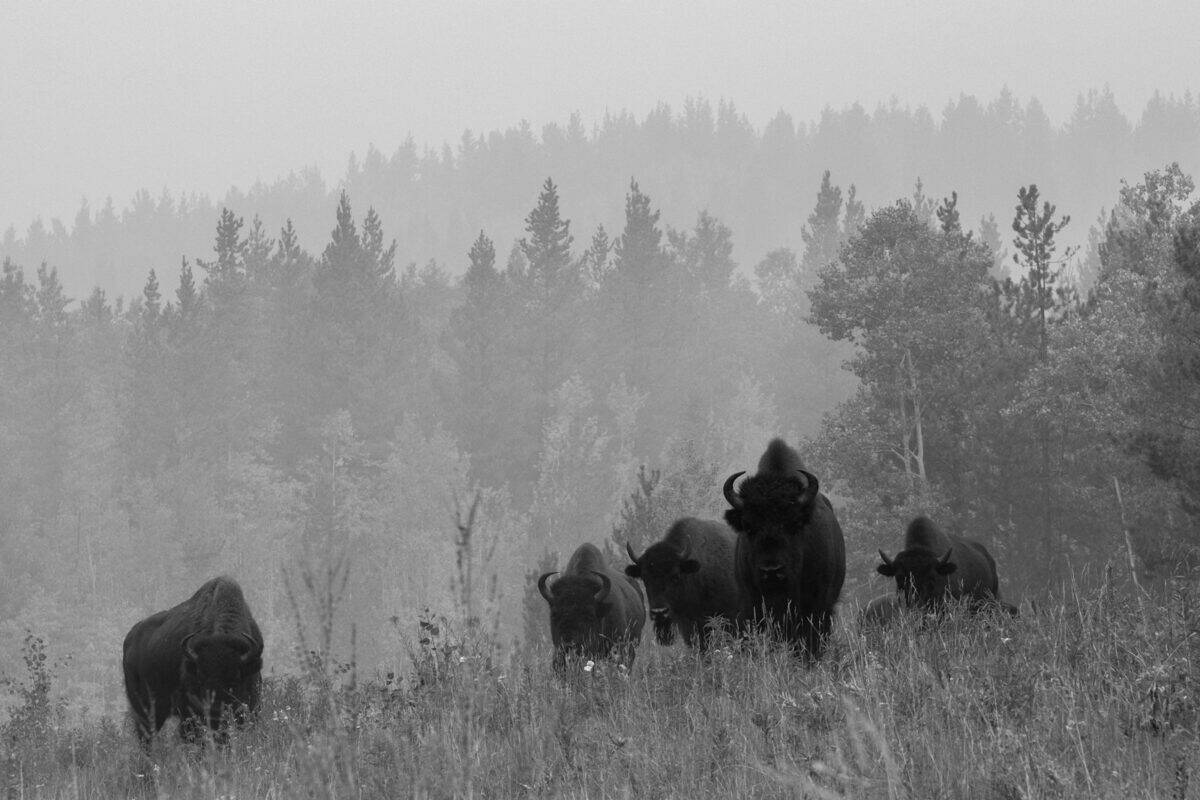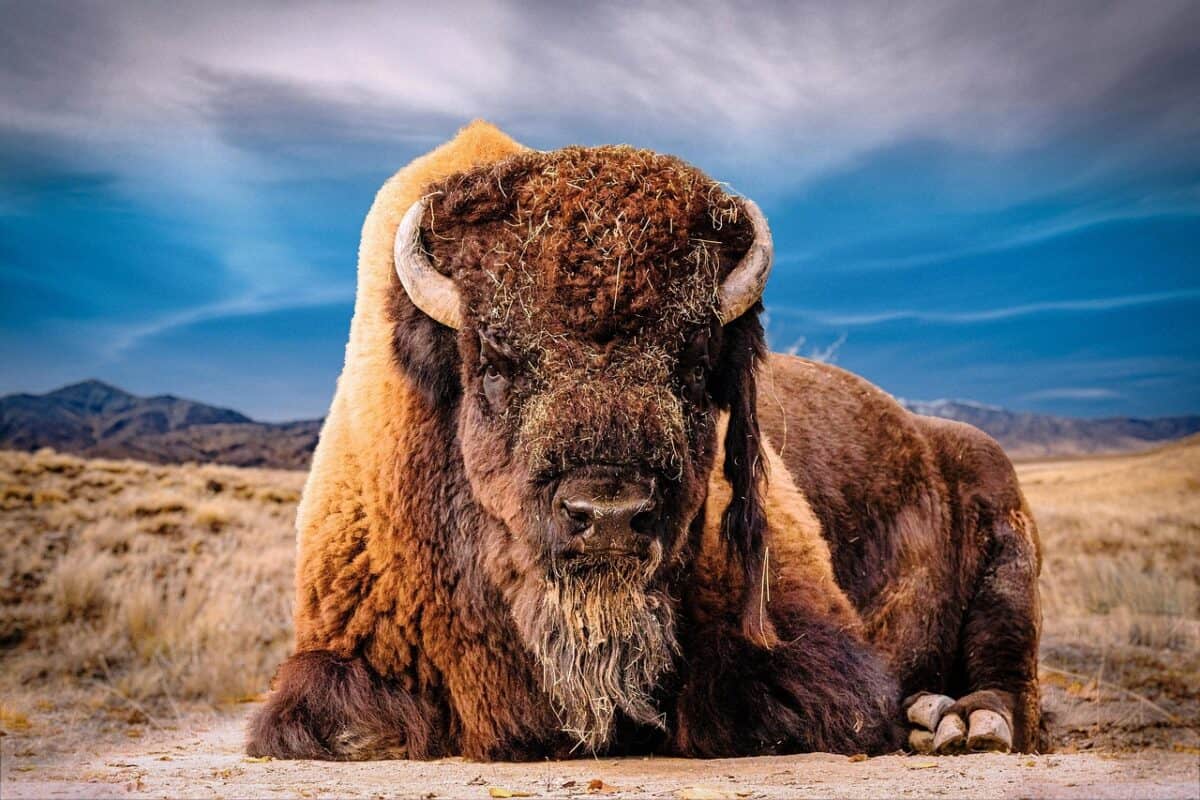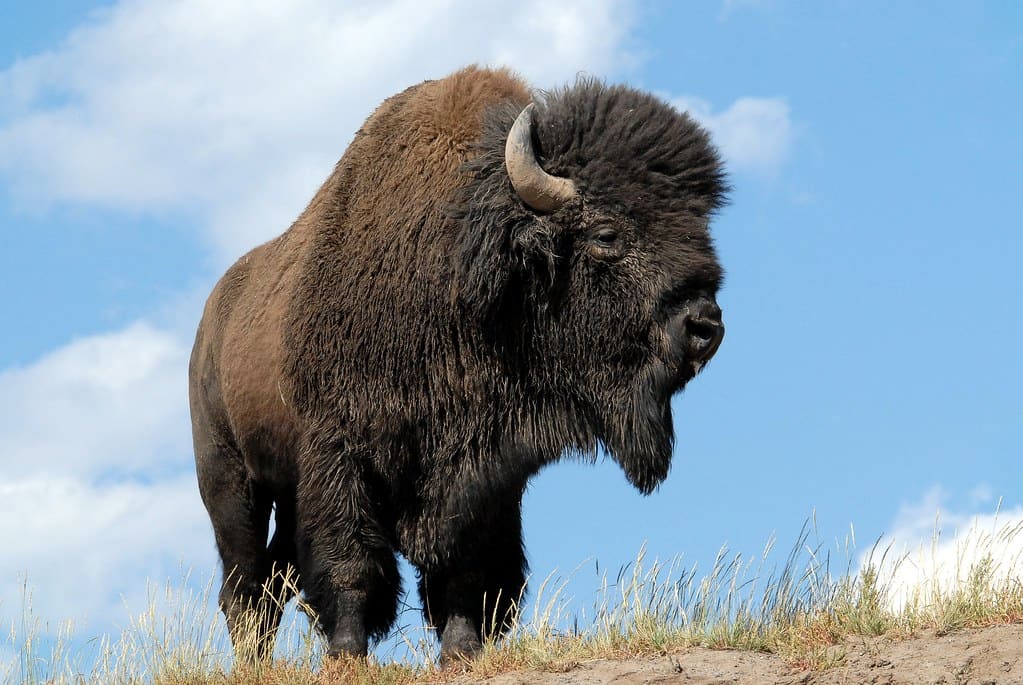Witnessing bison in their natural habitat is an awe-inspiring experience that connects us to America’s wild heritage. These magnificent creatures, which once roamed the plains by the millions, now attract wildlife enthusiasts to national parks and preserves across North America. However, despite their seemingly docile appearance, bison are wild animals that can be unpredictable and dangerous when disturbed. Each year, multiple visitors are injured—sometimes fatally—because they underestimated the speed, power, and territorial nature of these iconic mammals. This article provides essential safety guidelines to ensure your bison-viewing experience remains both memorable and safe, allowing you to appreciate these majestic animals while respecting their space and wild nature.
Understanding Bison Behavior The Foundation of Safety

Before encountering bison in the wild, it’s crucial to understand their behavior patterns. Bison are not simply large, slow-moving cows—they’re highly adapted wild animals capable of running at speeds up to 35 miles per hour and demonstrating remarkable agility despite weighing up to 2,000 pounds. These massive mammals have survived for centuries by maintaining strong defensive instincts that can trigger quickly when they feel threatened.
Bison communicate their discomfort through several warning signs: tail raising, pawing the ground, head shaking, snorting, or making bluffing charges. When a bison raises its tail into a more upright position, it’s often signaling agitation or preparing to charge. Learning to recognize these warning behaviors is your first line of defense when viewing bison safely. Remember that bison are especially unpredictable during mating season (July-August) and calving season (April-June), when their protective instincts are heightened.
Maintain a Safe Distance The 25-Yard Minimum Rule

The single most important safety guideline when viewing bison is maintaining adequate distance. National Park Service regulations require visitors to stay at least 25 yards (75 feet) away from bison at all times. This distance isn’t arbitrary—it accounts for the surprising speed and agility of bison while providing a buffer zone for both your safety and the animal’s comfort. Despite their massive size, bison can pivot quickly and charge with little warning.
Use the “rule of thumb” technique to gauge your distance: if you can extend your arm and cover the entire bison with your thumb, you’re likely at a safe distance. Always err on the side of caution by staying further away than you think necessary. Remember that no photograph or closer look is worth risking your safety or disturbing these wild animals. If you want a closer view, invest in quality binoculars or a camera with a telephoto lens instead of encroaching on the bison’s space.
Never Approach or Feed Bison

One of the most dangerous mistakes visitors make is attempting to approach or feed bison. Despite their occasionally calm demeanor, bison remain wild animals with unpredictable behavior. Approaching these animals not only puts you at risk of a defensive charge but also disrupts their natural behaviors and feeding patterns. Each year, multiple visitors are gored or trampled because they violated this fundamental rule of wildlife observation.
Feeding bison is equally dangerous and is strictly prohibited in national parks and wildlife refuges. Human food is not part of their natural diet and can cause health problems for the animals. Additionally, feeding wildlife creates dangerous associations between humans and food, potentially making bison more aggressive toward future visitors. Remember that these are self-sufficient wild animals that have thrived for thousands of years without human handouts.
Stay on Designated Trails and Viewing Areas

National parks and wildlife refuges have established designated trails and viewing areas specifically designed to provide safe wildlife observation opportunities while minimizing disruption to natural habitats. These designated areas typically offer natural barriers or appropriate distances from common bison gathering spots. By staying on established paths, you reduce the chances of surprising a bison or inadvertently positioning yourself between a bison and its perceived escape route.
Venturing off-trail is not only dangerous but may also damage fragile ecosystems and create new paths that confuse other visitors. Park rangers and wildlife managers have carefully designed these viewing areas based on years of observation and understanding of bison movement patterns. Trust their expertise and enjoy the views from these safe vantage points. If you encounter bison on or near a trail, wait patiently for them to move or consider backtracking to find an alternative route.
Use Your Vehicle as a Viewing Shield

Your vehicle provides an excellent viewing platform and safety shield when observing bison. Many wildlife management areas feature designated driving routes that allow visitors to witness bison from the protection of their vehicles. This approach is particularly valuable in places like Yellowstone National Park’s Lamar Valley or Theodore Roosevelt National Park, where bison frequently cross or congregate near roadways.
When using your vehicle as a viewing platform, follow these additional guidelines: remain inside your vehicle when bison are nearby, never drive off designated roads to get closer to animals, pull completely off the road if stopping to view wildlife (to allow other vehicles to pass safely), and keep your engine running in case you need to move quickly. Remember that although you’re protected inside your vehicle, bison can still damage cars if they feel threatened, so maintain a respectful distance even when viewing from your vehicle.
Recognize Heightened Danger During Mating and Calving Seasons

Bison behavior changes dramatically during certain times of the year, with mating season (July-August) and calving season (April-June) being particularly dangerous periods for human-bison interactions. During the rut (mating season), bulls become more aggressive as they compete for dominance and mating rights. They engage in fighting, wallowing, and demonstrative behaviors that make them more unpredictable and prone to perceiving humans as threats.
Calving season presents different risks, as mother bison are extremely protective of their young. A female bison with a calf will not hesitate to charge if she perceives any threat to her offspring. Even typically peaceful herds become more defensive during these periods. If visiting during these seasons, exercise extra caution by increasing your viewing distance beyond the minimum 25 yards and being especially attentive to warning signs. Watch for calves within herds and give these family groups an extra-wide berth, as mothers may interpret your presence as a threat to their vulnerable young.
Travel in Groups and Make Your Presence Known

When hiking or walking in bison country, traveling in groups offers several safety advantages. Larger groups are more visible to bison, reducing the chance of surprising an animal. Groups also appear more intimidating, potentially deterring bison from approaching. Additionally, traveling with companions means having help available should an emergency occur. Research shows that most bison-related injuries happen to solo hikers who inadvertently surprise animals or fail to recognize warning signs.
While moving through bison territory, make your presence known by talking in normal voices or occasionally clapping. Surprising a bison at close range dramatically increases the risk of a defensive reaction. However, avoid excessive noise that might stress or startle the animals. The goal is not to frighten bison but to ensure they’re aware of your presence from a safe distance. This approach gives the animals time to adjust to your presence or move away if they choose, reducing the likelihood of a dangerous encounter.
Keep Children Close and Dogs Leashed

Children and dogs require special attention in bison country. Children may not fully understand the dangers posed by bison and might be tempted to approach these seemingly docile animals. Keep children within arm’s reach at all times when bison are visible, and educate them about proper wildlife viewing etiquette before your visit. Small children, in particular, may be seen as less threatening by bison, potentially leading to dangerous curiosity from the animals.
Dogs present another significant risk factor in bison encounters. Even well-trained dogs may trigger a bison’s defensive or predatory instincts. National parks and most wildlife refuges require dogs to be leashed at all times, typically on leads no longer than six feet. In many prime bison habitats, dogs are prohibited entirely on certain trails or backcountry areas. If you’re traveling with a dog, research pet policies before your visit and always maintain complete control of your pet. A barking or lunging dog can quickly escalate a peaceful bison sighting into a dangerous confrontation.
Be Weather Aware When Viewing Bison

Weather conditions significantly influence bison behavior and your safety when viewing these animals. During extreme heat, bison may be more irritable and unpredictable as they seek shade and water. Conversely, in cold or windy conditions, your ability to hear warning sounds like snorting or detect subtle body language changes might be compromised. Rainy or foggy conditions reduce visibility and can lead to accidentally approaching bison too closely before noticing them.
Thunderstorms particularly affect bison behavior, sometimes causing herds to move quickly or unpredictably as they seek shelter. Lightning and sudden environmental changes can spook these animals, making them more defensive. Check weather forecasts before your bison-viewing expedition and adjust your plans accordingly. Early morning and late afternoon generally offer the best combination of bison activity and stable weather conditions for safe viewing, while also providing the best natural lighting for photography.
Carry and Know How to Use Bear Spray

While primarily marketed for bear encounters, bear spray can be an effective last-resort deterrent against charging bison. This capsaicin-based aerosol irritant creates a cloud that can discourage an approaching bison and potentially give you precious seconds to reach safety. Multiple studies have shown that bear spray is effective against large mammals including bison, though it should never be relied upon as your primary safety measure or an excuse to approach animals more closely.
If you carry bear spray, familiarize yourself with its proper use before your trip: know how to quickly remove it from its holster, disengage the safety mechanism, and spray effectively while under stress. Remember that bear spray is only effective at relatively close range (typically 12-30 feet) and should be considered an emergency tool of last resort, not a substitute for maintaining proper distance. Also be aware that wind conditions affect spray distribution, potentially blowing the irritant back toward you if used incorrectly. Never test bear spray in or near wildlife viewing areas, as residual scent can disturb animal behavior.
Know the Escape Routes and Safety Positions

Before settling in to observe bison, always identify potential escape routes and safety positions. Look for solid barriers like large trees, boulders, or vehicles that could offer protection if a bison becomes agitated. Avoid positioning yourself where retreat options are limited, such as against steep hillsides, water bodies, or in narrow ravines. Remember that bison can easily navigate terrain that might slow humans, including shallow water, snow, and moderately steep slopes.
If a bison does charge despite your precautions, wildlife experts recommend several emergency tactics. Running is generally ineffective as bison can easily outpace humans, reaching speeds of 35 mph. Instead, try to put a substantial object between yourself and the charging animal. If no shelter is available and contact seems imminent, lie face down, protect your head and neck with your arms, and remain still—playing dead may reduce the duration of the attack. However, the most effective strategy remains prevention through proper distance and awareness, making such last-resort measures unnecessary.
Respect Closures and Ranger Instructions

Wildlife management authorities occasionally implement temporary closures of certain areas to protect visitors and bison, particularly during sensitive periods like the rut or calving season. These closures are based on professional assessment of current conditions and animal behavior patterns. Always respect these restrictions, even if they limit access to popular viewing areas. Similarly, follow all instructions from park rangers and wildlife management personnel, who possess specialized knowledge about local bison populations and current behavior trends.
Many visitors don’t realize that approaching bison too closely is not just dangerous but also illegal in most protected areas. In Yellowstone National Park, for example, violating wildlife distance regulations can result in fines exceeding $5,000 and up to six months imprisonment in severe cases. Rangers don’t implement these rules arbitrarily—they’re designed to protect both visitors and the wild integrity of the bison populations. When in doubt about appropriate behavior or current conditions, stop by visitor centers for the most up-to-date information before heading out to view bison.
Report Dangerous Behavior—Both Human and Bison

Conservation of wild bison populations depends on maintaining appropriate relationships between these animals and human visitors. If you observe other visitors harassing bison, approaching too closely, feeding wildlife, or otherwise endangering themselves or the animals, report this behavior to park authorities promptly. Similarly, if you notice unusually aggressive bison behavior or animals that appear sick or injured, notify rangers. This information helps management teams address potential problems before they result in dangerous encounters.
Most parks offer multiple reporting options, including emergency numbers, visitor center contact information, and sometimes reporting apps specific to the park. Program these numbers into your phone before your visit, and note the location markers or trail names near your sighting to provide accurate information. Remember that reporting irresponsible behavior isn’t about getting others in trouble—it’s about preventing injuries and protecting both people and bison populations for future generations to enjoy.
Conclusion: Balancing Appreciation and Safety

Observing bison in their natural habitat offers a profound connection to America’s wild heritage and the complex ecosystems these keystone species help maintain. By following these safety guidelines, you can experience the majesty of wild bison while minimizing risks to yourself and disturbance to the animals. Remember that these precautions aren’t meant to diminish your experience but to enhance it by ensuring interactions remain positive for all involved.
As visitors to bison country, we carry dual responsibilities: protecting ourselves through informed behavior and protecting these magnificent animals by respecting their wild nature and space requirements. The most meaningful wildlife encounters happen when we observe animals behaving naturally, undisturbed by human presence. By maintaining appropriate distances, recognizing warning signs, and following established guidelines, you contribute to conservation efforts while creating lasting memories of these iconic symbols of American wilderness.
Whether you’re visiting Yellowstone, Theodore Roosevelt National Park, or other bison habitats, approach your wildlife viewing with patience, respect, and awareness. The extra effort to learn about bison behavior and follow safety protocols rewards you with authentic experiences that capture the true essence of these remarkable animals. Safe wildlife viewing ensures these opportunities remain available for generations to come, as we collectively work to protect and appreciate North America’s largest land mammals.
- 10 American Rivers Where You Should Never Swim - August 23, 2025
- 13 Surprising Animals Thriving in Urban America - August 23, 2025
- 13 Common Birdwatching Mistakes and How to Fix Them - August 23, 2025

